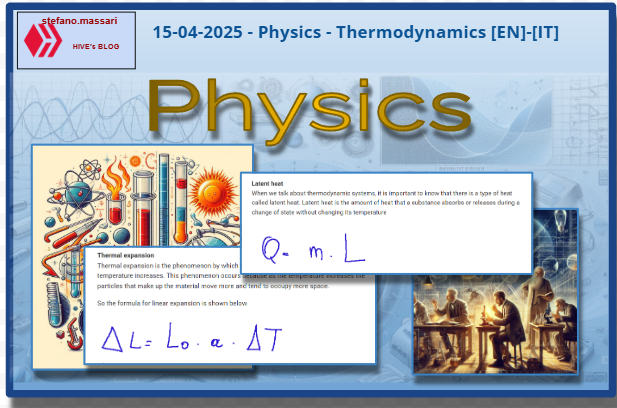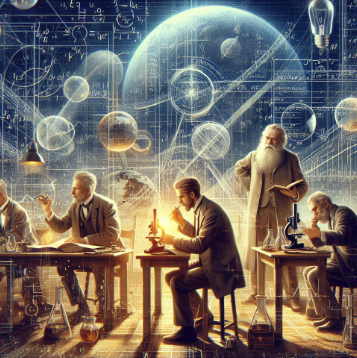
~~~ La versione in italiano inizia subito dopo la versione in inglese ~~~
ENGLISH

15-04-2025 - Physics - Thermodynamics [EN]-[IT]
With this post I would like to give a brief instruction about the topic mentioned in the subject
(code notes: X_66-65)
Thermodynamics

image created with artificial intelligence, the software used is Microsoft Copilot
Introduction
In this article I will try to talk about thermodynamics.
First of all let's explain what thermodynamics is. Thermodynamics is the branch of physics that deals with the study of thermal phenomena and their relationship with mechanical ones. We can also say that thermodynamics observes the evolution of the thermal state of a system.
When we want to define the thermal state of a system, it will be necessary to identify a series of physical quantities, these physical quantities are called system state parameters and are precisely quantities that characterize the system itself
Temperature
The main parameter used to define the thermal state of a system is precisely temperature. It is in fact considered one of the fundamental quantities of the international system of units of measurement. It is precisely from the temperature that gives the perception of the technical state of a system, that is, it gives the information whether that system produces heat or cold.
Zeroth law of thermodynamics
The zeroth law of thermodynamics is called this because it simply precedes all the others. This principle states that if two systems are in a state of thermal equilibrium with a third system, then they are in thermal equilibrium with each other.
Temperature measurement unit
The most popular scales for measuring temperature are 3: the Celsius scale (also called centigrade), the Fahrenheit scale, the Kelvin scale
Thermal expansion
Thermal expansion is the phenomenon by which a body increases its dimensions when the temperature increases. This phenomenon occurs because as the temperature increases the particles that make up the material move more and tend to occupy more space.
So the formula for linear expansion is shown below.

Where:
ΔL = length variation
L0 = Initial length
α = linear expansion coefficient of the material (depends on the material)
ΔT = temperature variation
Materials that are subject to thermal expansion and that we often see are railway tracks, bridges and wood
Thermodynamic systems
A thermodynamic system is defined as a macroscopic system that can be described through its state parameters.
A thermodynamic system can also be identified, through its appropriate parameters, as a part of a larger system or as a set of two macroscopic systems.
More simply we can say that a thermodynamic system is something on which we focus our attention to perform a thermodynamic analysis while the surrounding environment is called the environment. There are three types of thermodynamic systems.
We have the isolated system, the closed system and the open system.
The isolated system does not exchange energy or matter with the environment.
The closed system exchanges energy with the environment, but not matter.
The open system exchanges both energy and matter with the environment.
State of thermodynamic equilibrium
A closed system is in a state of thermodynamic equilibrium when it simultaneously presents mechanical equilibrium, thermal equilibrium and chemical equilibrium. Let's keep in mind that mechanical equilibrium with the environment occurs when the forces exerted by the environment on the system are balanced by the forces that the system exerts on the environment.
Heat
The quantity exchanged between two systems, which causes their temperature to vary, is called heat.
It must be kept in mind that heat is still a scalar quantity.
Latent heat
When we talk about thermodynamic systems, it is important to know that there is a type of heat called latent heat. Latent heat is the amount of heat that a substance absorbs or releases during a change of state without changing its temperature

Where:
Q = heat absorbed or released
m = mass of the substance
L = latent heat that varies based on the type of change of state and the substance
Thermodynamics Scientists

image created with artificial intelligence, the software used is Microsoft Copilot
Among the thermodynamics scientists we have illustrious names such as James Watt, Sadi Carnot, Rudolf Clausius, Lord Kelvin and James Prescott Joule.
Conclusions
Thermodynamics is considered a fundamental part of physics, because it studies how energy is transformed and how it moves between bodies in the form of heat and work.
Question
Did you know that the internal combustion engine (the engine of our cars) is a direct practical application of the principles of thermodynamics?

ITALIAN

15-04-2025 - Fisica - Termodinamica [EN]-[IT]
Con questo post vorrei dare una breve istruzione a riguardo dell’argomento citato in oggetto
(code notes: X_66-65)
Termodinamica

immagine creata con l’intelligenza artificiale, il software usato è Microsoft Copilot
Introduzione
In questo articolo proverò a parlare della termodinamica.
Innanzitutto spieghiamo che cos’è la termodinamica. La termodinamica è la branca della fisica che si occupa di studiare i fenomeni termici e la loro relazione con quelli meccanici. Possiamo anche dire che la termodinamica osserva l’evoluzione dello stato termico di un sistema.
Quando vogliamo definire lo stato termico di un sistema sarà necessario identificare una serie di grandezze fisiche, queste grandezze fisiche vengono chiamate come parametri di stato del sistema e sono appunto grandezze che caratterizzano il sistema stesso
La temperatura
Il principale parametro utilizzato per definire lo stato termico di un sistema è proprio la temperatura. Essa è considerata infatti una delle grandezze fondamentali del sistema di unità di misure internazionale. È proprio dalla temperatura che dà la percezione dello stato tecnico di un sistema, cioè da l’informazione se quel sistema produce caldo oppure freddo.
Principio zero della termodinamica
Il principio zero della termodinamica viene chiamato così perché precede semplicemente tutti gli altri. Questo principio afferma che se due sistemi sono in uno stato di equilibrio termico con un terzo sistema, allora sono in equilibrio termico tra loro.
Unità di misura della temperatura
Le scale più note per misurare la temperatura sono 3: la scala celsius (detta anche centigrada), la scala Fahrenheit, la scala Kelvin
Dilatazione termica
La dilatazione termica è il fenomeno per cui un corpo aumenta le sue dimensioni quando aumenta la temperatura. Questo fenomeno avviene perché con l’aumentare della temperatura le particelle che compongono il materiale si muovono di più e tendono ad occupare più spazio.
Quindi di seguito è mostrata la formula della dilatazione lineare.

Dove:
ΔL = variazione di lunghezza
L0 = Lunghezza iniziale
α = coefficiente di dilatazione lineare del materiale (dipende dal materiale)
ΔT = variazione di temperatura
I materiali che sono soggetti a dilatazione termica e che spesso vediamo sono i binari ferroviari, i ponti e il legno
Sistemi termodinamici
Viene definito sistema termodinamico un sistema macroscopico che riesce ad essere descritto tramite i suoi parametri di stato.
Un sistema termodinamico può essere identificato, tramite i suoi opportuni parametri, anche come una parte di un sistema più grande o come un insieme di due sistemi macroscopici.
Più semplicemente possiamo dire che un sistema termodinamico è qualcosa su cui concentriamo l’attenzione per eseguire un’analisi termodinamica mentre l’ambiente circostante viene chiamato ambiente. I sistemi termodinamici sono di tre tipologie.
Abbiamo il sistema isolato, il sistema chiuso ed il sistema aperto.
Il sistema isolato non scambia né energia, né materia con l’ambiente.
Il sistema chiuso scambia energia con l’ambiente, ma non materia.
Il sistema aperto scambia sia energia che materia con l’ambiente.
Stato di equilibrio termodinamico
Un sistema chiuso è in uno stato di equilibrio termodinamico quando esso presenta simultaneamente equilibrio meccanico, equilibrio termico ed equilibrio chimico. Teniamo presente che l’equilibrio meccanico con l’ambiente si ha quando le forze esercitate dall’ambiente sul sistema sono bilanciate dalle forze che il sistema esercita sull'ambiente.
Il calore
La grandezza scambiata tra due sistemi, che ne fa variare la temperatura, viene detta calore.
Bisogna tenere presente che il calore è comunque una grandezza scalare.
Calore latente
Quando parliamo di sistemi termodinamici, è importante sapere che esiste una tipologia di calore chiamata calore latente. Il calore latente è la quantità di calore che una sostanza assorbe o rilascia durante un cambiamento di stato senza variare la sua temperatura

Dove:
Q = calore assorbito o ceduto
m = massa della sostanza
L = calore latente che varia in base al tipo di cambiamento di stato e alla sostanza
Gli scienziati della termodinamica

immagine creata con l’intelligenza artificiale, il software usato è Microsoft Copilot
Tra gli studiosi della termodinamica abbiamo nomi illustri come, James Watt, Sadi Carnot, Rudolf Clausius, Lord Kelvin e James Prescott Joule.
Conclusioni
La termodinamica è considerata una parte fondamentale della fisica, perché studia come l'energia si trasforma e come si muove tra i corpi sotto forma di calore e lavoro.
Domanda
Lo sapevate che motore endotermico (il motore delle nostre autovetture) è una diretta applicazione pratica dei principi della termodinamica?
THE END
